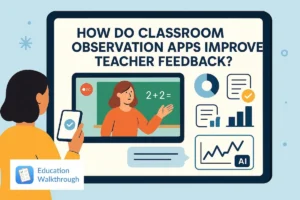The Danielson Framework helps educators improve their teaching. Developed by Charlotte Danielson, it sets clear standards for effective teaching. This tool supports teacher growth and student learning through structured evaluations. This article covers its key aspects, including components, benefits, and practical uses. Additionally, it explores various instructional strategies to enhance teaching effectiveness.
Key Takeaways
- The Danielson Framework for Teaching enhances educational outcomes through structured evaluation and professional growth across four key domains: Planning, Classroom Environment, Instruction, and Professional Responsibilities.
- Implementing the framework supports effective teacher evaluation and differentiated instruction, ultimately leading to improved student engagement and achievement. Effective classroom management is also a critical component that contributes to these positive outcomes.
- Professional Learning Communities (PLCs) and targeted coaching enhance collaboration among educators and facilitate continuous improvement in teaching practices based on the Danielson Framework.

The Danielson Framework for Teaching was introduced in 1996 by Charlotte Danielson as a means to facilitate meaningful discussions about effective teaching practices and to improve educational outcomes. This framework provides a comprehensive approach to teaching, clearly outlining the responsibilities of educators based on extensive research about enhancing student learning.
What sets the Danielson Framework apart is its focus on fostering professional growth through structured evaluation. Clear criteria for effective teaching help educators align their practices with educational standards, improving instructional quality and student achievement.
The Four Domains of the Danielson Framework

At the heart of the Danielson Framework are its four domains, which provide a structured approach to evaluating teaching effectiveness with an emphasis on professional growth. These domains encompass all aspects of teaching, including:
- Planning and preparation
- Classroom environment
- Instruction
- Professional responsibilities
This structured approach ensures a comprehensive evaluation of teaching practices and enhances instructional quality.
Addressing these key areas, the framework supports the development of a positive classroom environment, crucial for student engagement and learning. Effective classroom management is essential for creating a positive learning environment and is a key focus within the framework. Each domain offers a holistic set of criteria that guide teachers in creating an optimal learning experience for their students.
Components and Rubrics
The Danielson Framework for Teaching consists of 22 components organized into four main domains, providing a structured approach for evaluating teacher performance. These components are categorized under the domains of:
- Planning and Preparation
- Classroom Environment
- Instruction
- Professional Responsibilities
Each domain focuses on different aspects of teaching.
Within each component are elements that provide detailed criteria for assessing teacher effectiveness. These rubrics are designed to guide teacher evaluations, offering specific and measurable benchmarks for performance. Regular updates to the components and rubrics incorporate recent educational research and best practices, ensuring that the framework remains relevant and effective.
The Framework for Teaching Clusters reorganizes the components to highlight key ideas supporting student learning, further enhancing the framework’s implementation. This reorganization helps teachers and administrators focus on the most critical aspects of instructional practice, promoting comprehensive growth strategies and professional development. The Danielson Group provides updated resources, including these clusters, to assist educators in refining their teaching practices.
Teacher Evaluation Using the Danielson Framework

The Danielson Framework is structured to enhance teacher effectiveness and foster improved student learning outcomes through systematic evaluation and professional growth. Effective evaluation using this framework incorporates a focus on student well-being, equity, and understanding students’ backgrounds, ensuring that all students receive the support they need to succeed.
Teachers who utilize the framework report greater effectiveness in differentiating instruction to meet diverse student needs, which enhances overall student performance. Constructive, specific, and timely feedback is crucial in this process, as it maximizes its impact on instructional practices.
For instance, Lucy Prep integrates rigorous standards from the Danielson Framework within a cohesive instructional model to enhance collaboration among teachers.

The Danielson Framework aligns educational practices with standards, creating consistency and enhancing the overall quality of teaching in schools. Implementing the framework can lead to improved classroom management and increased collaboration among teachers, both of which are essential for student success.
Several schools have demonstrated the framework’s effectiveness in enhancing student achievement. P.S. 112 Jose Celso Barbosa involves stakeholders to develop practices aimed at improving student outcomes. Jaime Escalante and Maria Mayer Elementary Schools foster a supportive atmosphere for both emotional and academic success by utilizing the Framework for Great Schools.
Marble Hill High School’s portfolio presentation program allows students to articulate their learning experiences effectively, showcasing the framework’s impact on student engagement.
Professional Learning Communities and the Danielson Framework
The Danielson Framework emphasizes the importance of collaboration among teachers, which can be cultivated through structured Professional Learning Communities (PLCs). These communities foster a supportive environment that leads to improved educational practices and student success.
A successful PLC is characterized by shared ownership among participants, promoting collective responsibility rather than reliance on expert-led instruction. PLCs engage in inquiry cycles lasting between six to nine weeks, involving data analysis and monitoring to guide their improvement strategies. Effective PLCs should be anchored in a common vision of educational excellence, ensuring participants have a unified reference point for discussions and actions. Additionally, mutual trust and designated time for collaborative work are essential for PLCs to thrive.
Professional learning opportunities can be customized for specific teaching teams, schools, or districts to enhance the implementation of the Danielson Framework online. Asynchronous courses offered by the Danielson Group allow educators to engage with the framework at their own pace while reflecting on its application in their local context. The Danielson Group collaborates with over 1,500 organizations globally, offering various support and resources for educators.
Teacher Leadership and Coaching

Instructional leadership plays a crucial role in fostering collaborative environments where educators can share insights and strategies for implementing the Danielson Framework effectively. Teacher leaders who utilize the framework can guide their peers in adopting evidence-based instructional strategies that enhance student learning.
Coaching is instrumental in guiding teachers to reflect on their practices and enhance their instructional strategies. Focused coaching based on the Danielson Framework helps teachers engage in reflective practices, allowing them to identify strengths and areas for improvement in their instructional methods. Effective coaching can lead to improved teacher performance by promoting a culture of continuous learning and professional growth.
The Framework for Teaching Clusters within the Danielson Framework helps organize essential components, allowing for targeted coaching and professional growth among teachers. Facilitated virtual classrooms provide teachers with field practice and mentoring by specialists to strengthen their understanding of the framework.
Feedback and Reflective Practices
The Danielson Framework emphasizes the importance of a supportive environment for teachers, where constructive feedback can lead to continuous improvement in teaching practices. The rubrics within the framework are designed to facilitate reflective practices among educators.
The framework encourages teachers to focus on reflective practice, analyzing and improving their instructional strategies, which benefits student achievement. Regular reflection allows teachers to identify their strengths and areas for growth, facilitating targeted professional development.
Virtual Implementation of the Danielson Framework
Interactive digital resources have been developed to enhance understanding and application of the Danielson Framework’s components and rubrics. The Danielson Group provides remote training and resources that enable educators to implement the framework effectively in remote learning and virtual settings.
Integrating the Danielson Framework into existing evaluation processes helps create a seamless transition and maximizes its impact on teaching practices. Using technology to document and analyze data can streamline the implementation of the framework and facilitate better communication.
PLCs play a crucial role in fostering a culture of continuous improvement and innovation, especially in response to the challenges posed by remote and hybrid learning environments.
Educators can join the Danielson Group by subscribing to their mailing list to receive updates, resources, and opportunities for engagement. Signing up for the Danielson Group’s newsletter keeps educators informed about partnerships, upcoming courses, and new resources.
Joining the Danielson Group’s professional network encourages educators to share their experiences using the framework on social media platforms, fostering conversation and community among peers.
Case Studies and Examples
Case studies illustrate how the Danielson Framework can transform instructional practices, showcasing best practices across diverse educational settings. These examples allow educators to visualize the practical application of the framework in real classrooms.
One school district adopted the Danielson Framework, leading to improved collaboration among teachers and enhanced lesson planning. Another example involves a high school where teachers utilized the framework to create more student-centered learning environments.
An elementary school successfully employed the Danielson Framework to foster effective feedback practices, directly improving student engagement. The implementation of the framework has led to significant gains in student achievement, as evidenced by improved assessment scores. Teachers noted that using the framework allowed them to better assess student needs and tailor instruction accordingly.
Reflective practices encouraged by the framework have led to personal growth and collaboration among educators.
Wrapping Up The Danielson Framework
The Danielson Framework for Teaching offers a robust and comprehensive approach to instructional improvement and enhancing educational practices. By focusing on key domains, components, and rubrics, the framework provides clear guidelines for effective teaching and professional growth. Implementing this framework can lead to improved classroom management, increased student engagement, and higher student achievement.
As we continue to strive for excellence in education, the Danielson Framework serves as a valuable tool for educators seeking to maximize their impact. Embrace the framework, foster collaboration, and witness firsthand the transformative power of effective teaching practices.
Common Questions On Danielson Framework
What is the Danielson Framework for Teaching?
The Danielson Framework for Teaching is a comprehensive evaluation tool developed by Charlotte Danielson, aimed at enhancing instructional quality and fostering effective teaching practices by adhering to established teaching standards. It serves as a structured guide for educators to reflect on and improve their teaching.
How many components are in the Danielson Framework?
The Danielson Framework comprises 22 components divided into four main domains: Planning and Preparation, Classroom Environment, Instruction, and Professional Responsibilities. These components serve as the evaluation criteria for assessing teacher performance.
How does the Danielson Framework enhance student achievement?
The Danielson Framework enhances student achievement by aligning educational practices with standards and promoting teacher collaboration, which improves classroom management, instructional strategies, and instructional quality. This structured approach leads to better learning outcomes for students.
What are Professional Learning Communities (PLCs)?
Professional Learning Communities (PLCs) are collaborative groups of educators focused on enhancing teaching practices and student outcomes through collaborative learning, particularly in alignment with the Danielson Framework. This structured approach fosters continuous professional development among teachers.
How can I join the Danielson Group?
To join the Danielson Group’s professional network, subscribe to their mailing list for updates and resources, and engage with the community by sharing your experiences on social media. This will help you stay connected and involved.



